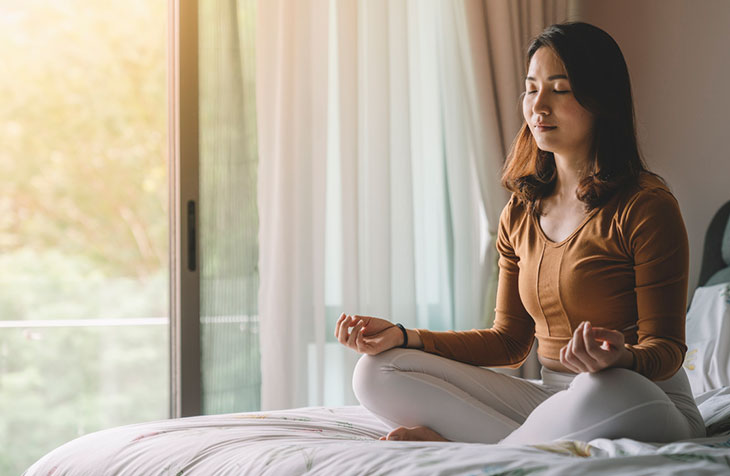How to Meditate? Checking Out Different Methods for a Serene Mind
Wiki Article
How to Meditate: A Detailed Method to Achieving Mindfulness and Calmness
Reflection functions as an effective tool for accomplishing mindfulness and emotional calmness in a fast-paced world. By understanding the essential principles and strategies entailed in reflection, people can grow a method that improves their overall health. This conversation will certainly detail essential steps, from developing a conducive atmosphere to incorporating meditation right into daily routines. As we check out these components, it ends up being clear that the trip to mindfulness is not just regarding the act of resting in silence, but rather about promoting a deeper connection with oneself and the globe around us. What might this transformation entail?Recognizing Meditation
Recognizing reflection includes comprehending its essential principles and techniques, which serve as the foundation for the practice. At its core, reflection is a psychological workout aimed at advertising leisure, building internal power, and creating concern and understanding. The technique motivates individuals to focus their focus, often with methods such as deep breathing, visualization, or mantra repetition.Reflection can be categorized into numerous designs, including mindfulness, transcendental, and loving-kindness meditation, each with distinctive objectives and approaches. Mindfulness meditation stresses present-moment understanding and non-judgmental monitoring of ideas and feelings, while transcendental reflection includes the use of particular mantras to go beyond common idea procedures. Loving-kindness meditation focuses on creating a perspective of love and empathy in the direction of oneself and others.
No matter of the method utilized, the primary goal continues to be consistent: to grow a deeper understanding of the mind and its patterns. This self-awareness promotes psychological durability, quality of idea, and an extensive sense of calm (How to meditate?). By recognizing these strategies and principles, people prepared for an effective meditation technique that can dramatically enhance their general well-being
Getting Ready For Your Practice
Before beginning your reflection technique, it is important to produce an atmosphere helpful to concentrate and relaxation. Guarantee that the location is free and clean of clutter, as a tidy setting can help clear the mind.Think about the illumination, as all-natural light can enhance your state of mind and power. Soft, cozy lights is often more calming than severe fluorescent lights. Additionally, select a comfortable temperature, making sure that you are neither as well hot nor also chilly.
Incorporating components that promote peace can even more enhance your experience. This may include soft cushions or coverings for comfort, as well as soothing aromas from essential oils or incense. It can likewise be useful to have a timer set for your reflection session to avoid disturbances from clock-watching.
Standard Meditation Methods

One more reliable technique is body check meditation. This includes psychologically checking your body from head to toe, noticing any type of locations of stress or discomfort and purposely relaxing those muscle mass. This technique cultivates a deeper connection between your body and mind.
Discover More Here

Finally, loving-kindness meditation concentrates on cultivating compassion in the direction of on your own and others. Silently repeat expressions of goodwill, enhancing psychological well-being and interconnectedness. Each of these strategies offers as a foundation for your reflection journey, permitting you to discover the method that reverberates best with your individual method.
Maintaining Emphasis and Mindfulness

Developing a dedicated reflection area can improve the capability to preserve mindfulness. A silent, clean setting minimizes disturbances, permitting deeper immersion in the technique. In addition, establishing a time restriction can assist manage expectations; starting with much shorter sessions may reduce the change into longer techniques.
Using methods such as body scanning or observing sensations can likewise strengthen mindfulness. These techniques motivate specialists to remain present her comment is here and engaged with their physicality, securing their attention in the moment. Routine method is important; the mind constructs strength over time, creating a stronger ability for focus.
Incorporating Meditation Into Life
Including reflection right into daily life can change regular activities right into chances for mindfulness and self-reflection. By integrating mindfulness methods into typical jobs, people can grow a greater feeling of existence and harmony in the middle of the busyness of daily life.Begin by identifying minutes throughout your day where you can pause and practice mindfulness. Also mundane tasks like strolling or washing dishes can come to be chances for reflection by directing your focus to try this the experiences of movement and the noises surrounding you.
Furthermore, alloting committed times for reflection can enhance its practice. Beginning with short sessions, gradually raising period as you end up being more comfortable. Use tips or hints-- like a particular time of day or a soothing audio-- to develop consistency.
Inevitably, the goal is to weave mindfulness into the material of daily life, enabling you to approach each minute with intention, thus improving your total feeling of health and clearness.
Verdict
Finally, effective meditation requires a quiet setting, a comfy placement, and a focus on the breath. By enabling ideas to arise without judgment and constantly rerouting focus to the breath, practitioners can attain improved mindfulness and tranquility. Incorporating different methods, such as body scanning and loving-kindness expressions, can additionally enrich the technique. Regular reflection, even in short sessions, promotes a much deeper connection to the existing moment, eventually resulting in better calmness and mental clearness in every day life.Meditation can be classified into various styles, consisting of mindfulness, transcendental, and loving-kindness reflection, each with distinct functions and techniques. Mindfulness meditation highlights present-moment awareness and non-judgmental monitoring of ideas and feelings, while copyright includes the usage of specific mantras to go beyond average idea procedures.With your meditation area prepared, it's time to explore various standard reflection strategies that can assist cultivate mindfulness and inner peace.Regularly keeping emphasis and mindfulness throughout meditation can be tough, especially for those new to the practice.Establishing a dedicated meditation space can boost the capability to keep mindfulness.
Report this wiki page